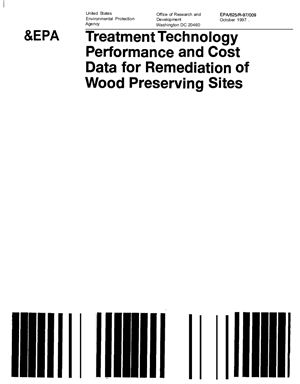EPA/625/R-97/
009. Center for Environmental Research Information. National Risk Management Research Laboratory. Office of Research and Development. U.S. Environmental Protection Agency. Cincinnati, Ohio. October 1997 -- 122 pages
Wood preserving has been an industry in North America for more than 100 years. During this time, wood preserving facilities have utilized a variety of compounds, including pentachlorophenol (PCP), creosote, and certain metals to extend the useful life of wood products. Past operations and waste management practices have resulted in soil and water contamination at a portion of the more than 700 wood preserving sites identified in the United States. Many of these sites are currently being addressed under Federal, State, or voluntary cleanup programs. The U.S. Environmental Protection Agency (EPA) National Risk Management Research Laboratory (NRMRL) has responded to the need for credible information aimed at facilitating remediation of wood preserving sites by conducting treatability studies, issuing guidance, and preparing reports.
This report presents information pertaining to applicable treatment and control alteatives for the remediation of contaminated soil and water at wood preserving sites. It provides background information on the wood preserving industry; common contaminants, including pentachlorophenol (PCP), polycyclic aromatic hydrocarbons (PAHs), polychlorinated dibenzo-pdioxins and polychlorinated dibenzofurans (PCDDs/PCDFs), and metals-containing compounds, such as chromated copper arsenate (CCA); and environmental conces associated with these contaminants.
Ten technologies previously employed for remediation of soil and water at wood preserving sites are discussed. For soil, the advantages, limitations, and costs associated with implementation of soil washing, solidification/stabilization (S/S), t,hermal desorption (TD), incineration, solvent extraction, base-catalyzed decomposition (BCD), and bioremediation are presented. Treatability and/or case studies are provided for each technology. Similar information is provided for the remediation of water using photolytic oxidation, carbon adsorption, hydraulic containment, and bioremediation. Sources of additional information, in the form of documents and databases, are also listed. The appendices provide a list of known wood preserving sites and additional soil and water treatability and case studies.
009. Center for Environmental Research Information. National Risk Management Research Laboratory. Office of Research and Development. U.S. Environmental Protection Agency. Cincinnati, Ohio. October 1997 -- 122 pages
Wood preserving has been an industry in North America for more than 100 years. During this time, wood preserving facilities have utilized a variety of compounds, including pentachlorophenol (PCP), creosote, and certain metals to extend the useful life of wood products. Past operations and waste management practices have resulted in soil and water contamination at a portion of the more than 700 wood preserving sites identified in the United States. Many of these sites are currently being addressed under Federal, State, or voluntary cleanup programs. The U.S. Environmental Protection Agency (EPA) National Risk Management Research Laboratory (NRMRL) has responded to the need for credible information aimed at facilitating remediation of wood preserving sites by conducting treatability studies, issuing guidance, and preparing reports.
This report presents information pertaining to applicable treatment and control alteatives for the remediation of contaminated soil and water at wood preserving sites. It provides background information on the wood preserving industry; common contaminants, including pentachlorophenol (PCP), polycyclic aromatic hydrocarbons (PAHs), polychlorinated dibenzo-pdioxins and polychlorinated dibenzofurans (PCDDs/PCDFs), and metals-containing compounds, such as chromated copper arsenate (CCA); and environmental conces associated with these contaminants.
Ten technologies previously employed for remediation of soil and water at wood preserving sites are discussed. For soil, the advantages, limitations, and costs associated with implementation of soil washing, solidification/stabilization (S/S), t,hermal desorption (TD), incineration, solvent extraction, base-catalyzed decomposition (BCD), and bioremediation are presented. Treatability and/or case studies are provided for each technology. Similar information is provided for the remediation of water using photolytic oxidation, carbon adsorption, hydraulic containment, and bioremediation. Sources of additional information, in the form of documents and databases, are also listed. The appendices provide a list of known wood preserving sites and additional soil and water treatability and case studies.

